Evaluating the Dominant Controls of Water Erosion in Three Dry Valley Types Using the RUSLE and Geodetector Method
Abstract
:1. Introduction
2. Materials and Methods
2.1. Study Area
2.2. Data and Methods
3. Results
3.1. Characteristics of Water Erosion in the Three Dry Valley Subtypes
3.2. Dominant Controls and Discrepancies of Water Erosion in the Dry Valley Subtypes
3.3. Identification of High-Risk Regions in Relation to Water Erosion
4. Discussion
4.1. Model Validation
4.2. Spatial Pattern of Soil Erosion
4.3. Driving Factors of Water Erosion
4.4. Challenges and Perspectives
5. Conclusions
Author Contributions
Funding
Institutional Review Board Statement
Informed Consent Statement
Data Availability Statement
Acknowledgments
Conflicts of Interest
References
- Borrelli, P.; Robinson, D.A.; Fleischer, L.R.; Lugato, E.; Ballabio, C.; Alewell, C.; Meusburger, K.; Modugno, S.; Schütt, B.; Ferro, V.; et al. An assessment of the global impact of 21st century land use change on soil erosion. Nat. Commun. 2017, 8, 2013. [Google Scholar] [CrossRef] [PubMed] [Green Version]
- Fu, B.; Tian, T.; Liu, Y.; Zhao, W. New Developments and Perspectives in Physical Geography in China. Chin. Geogr. Sci. 2019, 29, 363–371. [Google Scholar] [CrossRef] [Green Version]
- Koirala, P.; Thakuri, S.; Joshi, S.; Chauhan, R. Estimation of Soil Erosion in Nepal Using a RUSLE Modeling and Geospatial Tool. Geosciences 2019, 9, 147. [Google Scholar] [CrossRef] [Green Version]
- Zhang, G.; Cui, P.; Yin, Y.; Liu, D.; Jin, W.; Wang, H.; Yan, Y.; Ahmed, B.N.; Wang, J. Real-time monitoring and estimation of the discharge of flash floods in a steep mountain catchment. Hydrol. Process. 2019, 33, 3195–3212. [Google Scholar] [CrossRef]
- Zhang, G.; Cui, P.; Jin, W.; Zhang, Z.; Wang, H.; Bazai, N.A.; Li, Y.; Liu, D.; Pasuto, A. Changes in hydrological behaviours triggered by earthquake disturbance in a mountainous watershed. Sci. Total Environ. 2021, 760, 143349. [Google Scholar] [CrossRef] [PubMed]
- Phinzi, K.; Ngetar, N.S. The assessment of water-borne erosion at catchment level using GIS-based RUSLE and remote sensing: A review. Int. Soil Water Conserv. Res. 2019, 7, 27–46. [Google Scholar] [CrossRef]
- Borrelli, P.; Alewell, C.; Alvarez, P.; Anache, J.A.A.; Baartman, J.; Ballabio, C.; Bezak, N.; Biddoccu, M.; Cerdà, A.; Chalise, D.; et al. Soil erosion modelling: A global review and statistical analysis. Sci. Total Environ. 2021, 780, 146494. [Google Scholar] [CrossRef]
- Alewell, C.; Borrelli, P.; Meusburger, K.; Panagos, P. Using the USLE: Chances, challenges and limitations of soil erosion modelling. Int. Soil Water Conserv. Res. 2019, 7, 203–225. [Google Scholar] [CrossRef]
- Panagos, P.; Ballabio, C.; Borrelli, P.; Meusburger, K.; Klik, A.; Rousseva, S.; Tadić, M.P.; Michaelides, S.; Hrabalíková, M.; Olsen, P.; et al. Rainfall erosivity in Europe. Sci. Total Environ. 2015, 511, 801–814. [Google Scholar] [CrossRef] [Green Version]
- Grillakis, M.G.; Polykretis, C.; Alexakis, D.D. Past and projected climate change impacts on rainfall erosivity: Advancing our knowledge for the eastern Mediterranean island of Crete. Catena 2020, 193, 104625. [Google Scholar] [CrossRef]
- Stoate, C.; Boatman, N.; Borralho, R.; Carvalhob, C.R.; Snoo, G.; Eden, P. Ecological impacts of arable intensification in Europe. J. Environ. Manag. 2001, 63, 337–365. [Google Scholar] [CrossRef] [PubMed]
- Liu, B.; Xie, Y.; Li, Z.; Liang, Y.; Zhang, W.; Fu, S.; Yin, S.; Wei, X.; Zhang, K.; Wang, Z.; et al. The assessment of soil loss by water erosion in China. Int. Soil Water Conserv. Res. 2020, 8, 430–439. [Google Scholar] [CrossRef]
- Wang, Y.; Dai, E.; Yin, L.; Ma, L. Land use/land cover change and the effects on ecosystem services in the Hengduan Mountain region, China. Ecosyst. Serv. 2018, 34, 55–67. [Google Scholar] [CrossRef]
- Su, Z.; Xiong, D.; Zhang, J.; Zhou, T.; Yang, H.; Dong, Y.; Fang, H.; Shi, L. Variation in the vertical zonality of erodibility and critical shear stress of rill erosion in China’s Hengduan Mountains. Earth Surf. Process. Landf. 2018, 44, 88–97. [Google Scholar] [CrossRef]
- Zhu, G.-F.; Yang, L.; Qin, D.-H.; Tong, H.-L.; Liu, Y.-F.; Li, J.-F. Spatial and temporal variation of drought index in a typical steep alpine terrain in Hengduan Mountains. J. Mt. Sci. 2016, 13, 1186–1199. [Google Scholar] [CrossRef]
- Schweinfurth, U. Mapping mountains: Vegetation in the Himalaya. GeoJournal 1992, 27, 73–83. [Google Scholar] [CrossRef]
- Wangda, P.; Ohsawa, M. Gradational Forest Change along the Climatically Dry Valley Slopes of Bhutan in the Midst of Humid Eastern Himalaya. Plant Ecol. 2006, 186, 109–128. [Google Scholar] [CrossRef]
- Lin, Y.-M.; Cui, P.; Ge, Y.-G.; Chen, C.; Wang, D.-J.; Wu, C.-Z.; Li, J.; Yu, W.; Zhang, G.-S.; Lin, H. The succession characteristics of soil erosion during different vegetation succession stages in dry-hot river valley of Jinsha River, upper reaches of Yangtze River. Ecol. Eng. 2014, 62, 13–26. [Google Scholar] [CrossRef]
- Duan, X.; Liu, B.; Gu, Z.; Rong, L.; Feng, D. Quantifying soil erosion effects on soil productivity in the dry-hot valley, southwestern China. Environ. Earth Sci. 2016, 75, 1164. [Google Scholar] [CrossRef]
- He, Z.Y.; Su, Z.A.; Xiong, D.H.; Wang, Y.; Yang, H.K. Effects of Agave americana on soil and water conservation of slope in dry-hot valley of Jinsha River. Mount. Res. 2018, 36, 731–739. [Google Scholar] [CrossRef]
- Xin, Z.-Y.; Xia, J.-G. Soil erosion calculation in the hydro-fluctuation belt by adding water erosivity factor in the USLE model. J. Mt. Sci. 2020, 17, 2123–2135. [Google Scholar] [CrossRef]
- Jiang, L.; Bian, J.H.; Li, A.N.; Lei, G.B.; Nan, X.; Feng, W.L.; Li, G. Spatial-temporal changes of soil erosion in the upper reachers of Minjiang River from 2000 to 2010. J. Soil Water Conserv. 2014, 28, 18–25. [Google Scholar] [CrossRef]
- Perović, V.; Jakšić, D.; Jaramaz, D.; Koković, N.; Čakmak, D.; Mitrović, M.; Pavlović, P. Spatio-temporal analysis of land use/land cover change and its effects on soil erosion (Case study in the Oplenac wine-producing area, Serbia). Environ. Monit. Assess. 2018, 190, 675. [Google Scholar] [CrossRef]
- Gioia, D.; Amodio, A.M.; Maggio, A.; Sabia, C. Impact of Land Use Changes on the Erosion Processes of a Degraded Rural Landscape: An Analysis Based on High-Resolution DEMs, Historical Images, and Soil Erosion Models. Land 2021, 10, 673. [Google Scholar] [CrossRef]
- Apollonio, C.; Petroselli, A.; Tauro, F.; Cecconi, M.; Biscarini, C.; Zarotti, C.; Grimaldi, S. Hillslope Erosion Mitigation: An Experimental Proof of a Nature-Based Solution. Sustainability 2021, 13, 6058. [Google Scholar] [CrossRef]
- Stanchi, S.; Zecca, O.; Hudek, C.; Pintaldi, E.; Viglietti, D.; D’Amico, M.E.; Colombo, N.; Goslino, D.; Letey, M.; Freppaz, M. Effect of Soil Management on Erosion in Mountain Vineyards (N-W Italy). Sustainability 2021, 13, 1991. [Google Scholar] [CrossRef]
- Panagos, P.; Ballabio, C.; Borrelli, P.; Meusburger, K. Spatio-temporal analysis of rainfall erosivity and erosivity density in Greece. Catena 2016, 137, 161–172. [Google Scholar] [CrossRef]
- Ballabio, C.; Borrelli, P.; Spinoni, J.; Meusburger, K.; Michaelides, S.; Beguería, S.; Klik, A.; Petan, S.; Janeček, M.; Olsen, P.; et al. Mapping monthly rainfall erosivity in Europe. Sci. Total Environ. 2017, 579, 1298–1315. [Google Scholar] [CrossRef] [PubMed] [Green Version]
- Wang, J.F.; Xu, C.D. Geodetector: Principle and prospective. Acta Geogr. Sin. 2017, 72, 116–134. [Google Scholar]
- Chu, L.; Sun, T.; Wang, T.; Li, Z.; Cai, C. Temporal and Spatial Heterogeneity of Soil Erosion and a Quantitative Analysis of Its Determinants in the Three Gorges Reservoir Area, China. Int. J. Environ. Res. Public Health 2020, 17, 8486. [Google Scholar] [CrossRef] [PubMed]
- Liang, S.X.; Fang, H. Quantitative analysis of driving factors in soil erosion using geographic detectors in Qiantang River catckment, Southeast China. J. Soils Sediments 2020, 1, 134–147. [Google Scholar] [CrossRef]
- Yu, Y.; Shen, Y.; Wang, J.; Wei, Y.; Liu, Z. Simulation and mapping of drought and soil erosion in Central Yunnan Province, China. Adv. Space Res. 2021, 68, 4556–4572. [Google Scholar] [CrossRef]
- Zhao, Y.; Liu, L.; Kang, S.; Ao, Y.; Han, L.; Ma, C. Quantitative Analysis of Factors Influencing Spatial Distribution of Soil Erosion Based on Geo-Detector Model under Diverse Geomorphological Types. Land 2021, 10, 604. [Google Scholar] [CrossRef]
- Sun, L.; Cai, Y.; Yang, W.; Yi, Y.; Yang, Z. Climatic variations within the dry valleys in southwestern China and the influences of artificial reservoirs. Clim. Chang. 2019, 155, 111–125. [Google Scholar] [CrossRef]
- Hu, K.; Wu, C.; Tang, J.; Pasuto, A.; Li, Y.; Yan, S. New understandings of the June 24th 2017 Xinmo Landslide, Maoxian, Sichuan, China. Landslides 2018, 15, 2465–2474. [Google Scholar] [CrossRef] [Green Version]
- Bai, C.; Kang, G.; Gao, G. Distribution of the Crustal Magnetic Field in Sichuan-Yunnan Region, Southwest China. Sci. World J. 2014, 2014, 854769. [Google Scholar] [CrossRef] [PubMed]
- Yang, C.; Su, Z.-A.; Fan, J.-R.; Fang, H.-D.; Shi, L.-T.; Zhang, J.-H.; He, Z.-Y.; Zhou, T.; Wang, X.-Y. Simulation of the landform change process on a purple soil slope due to tillage erosion and water erosion using UAV technology. J. Mt. Sci. 2020, 17, 1333–1344. [Google Scholar] [CrossRef]
- Urabe, A.; Nakaya, H.; Muto, T.; Katoh, S.; Hyodo, M.; Xue, S.R. Lithostratigraphy and depositional history of the Late Ce-nozoic hominid-bearing successions in the Yuanmou Basin, southwest China. Quat. Sci. Rev. 2001, 20, 1671–1681. [Google Scholar] [CrossRef]
- Fan, J.R.; Yang, C.; Bao, W.K.; Liu, J.L.; Li, X. Distribution Scope and District Statistical Analysis of Dry Valleys in Southwest China. Mount. Res. 2020, 38, 303–313. [Google Scholar]
- Zhang, W.B.; Fu, J.S. Rainfall erosivity estimation under different rainfall amount. Resour. Sci. 2003, 25, 35–41. [Google Scholar]
- Zhu, D.; Xiong, K.; Xiao, H.; Gu, X. Variation characteristics of rainfall erosivity in Guizhou Province and the correlation with the El Niño Southern Oscillation. Sci. Total Environ. 2019, 691, 835–847. [Google Scholar] [CrossRef]
- Benavidez, R.; Jackson, B.; Maxwell, D.; Norton, K. A review of the (Revised) Universal Soil Loss Equation ((R)USLE): With a view to increasing its global applicability and improving soil loss estimates. Hydrol. Earth Syst. Sci. 2018, 22, 6059–6086. [Google Scholar] [CrossRef] [Green Version]
- Liu, B.Y.; Nearing, M.A.; Shi, P.J.; Jia, Z.W. Slope gradient effects on soil loss for steep slopes. Trans. ASAE 1994, 37, 1835–1840. [Google Scholar] [CrossRef]
- Ghosal, K.; Das Bhattacharya, S. A Review of RUSLE Model. J. Indian Soc. Remote Sens. 2020, 48, 689–707. [Google Scholar] [CrossRef]
- Cai, C.F.; Ding, S.W.; Shi, Z.H.; Hang, L.; Zhang, G.Y. Study of applying USLE and geographical information system IDRISI to predict soil erosion in small watershed. J. Soil. Water Conserv. 2000, 14, 19–23. [Google Scholar]
- Wang, J.F.; Zhang, T.L.; Fu, B.J. A measure of spatial stratified heterogeneity. Ecol. Indic. 2016, 67, 250–256. [Google Scholar] [CrossRef]
- Yang, M.; Li, X.; Hu, Y.; He, X. Assessing effects of landscape pattern on sediment yield using sediment delivery distributed model and a landscape indicator. Ecol. Indic. 2012, 22, 38–52. [Google Scholar] [CrossRef]
- Guo, B.; Liu, L.F.; Jiang, L.; Fan, Y.W.; Zhang, H.; He, T.L. Analysis of tempo-spatial of erosion intensity in Dadu River Catchment. J. Shandong Univ. Technol. (Nat. Sci. Ed.) 2019, 33, 7–13. [Google Scholar] [CrossRef]
- Gao, J.; Wang, H. Temporal analysis on quantitative attribution of karst soil erosion: A case study of a peak-cluster depression basin in Southwest China. Catena 2019, 172, 369–377. [Google Scholar] [CrossRef]
- Lin, J.; Guan, Q.; Tian, J.; Wang, Q.; Tan, Z.; Li, Z.; Wang, N. Assessing temporal trends of soil erosion and sediment redistribution in the Hexi Corridor region using the integrated RUSLE-TLSD model. Catena 2020, 195, 104756. [Google Scholar] [CrossRef]
- Yang, X.; Guo, B.; Lu, Y.F.; Zhang, R.; Zhang, D.F.; Zhen, X.Y.; Chen, S.T.; Wu, H.W.; Wei, C.X.; Yang, L.A.; et al. Spatial–temporal evolution patterns of soil erosion in the Yellow River Basin from 1990 to 2015: Impacts of natural factors and land use change. Geomat. Nat. Hazards Risk 2021, 12, 103–122. [Google Scholar] [CrossRef]
- Fang, H. Impacts of rainfall and soil conservation measures on soil, SOC, and TN losses on slopes in the black soil region, northeastern China. Ecol. Indic. 2021, 129, 108016. [Google Scholar] [CrossRef]
- Dai, E.; Yin, L.; Wang, Y.; Ma, L.; Tong, M. Quantitative Assessment of the Relative Impacts of Land Use and Climate Change on the Key Ecosystem Services in the Hengduan Mountain Region, China. Sustainability 2020, 12, 4100. [Google Scholar] [CrossRef]
- Wang, J.; Zhang, W.; Zhang, Z. Impacts of Land-Use Changes on Soil Erosion in Water–Wind Crisscross Erosion Region of China. Remote Sens. 2019, 11, 1732. [Google Scholar] [CrossRef] [Green Version]
- Chen, L.; Fan, M.; Wang, Q. Spatial priority conservation areas for vegetation habitat across the Upper Reaches of Min River located in Sichuan Province, China. Glob. Ecol. Conserv. 2019, 17, e00578. [Google Scholar] [CrossRef]
- Panagos, P.; Borrelli, P.; Meusburger, K.; Yu, B.; Klik, A.; Lim, K.J.; Yang, J.E.; Ni, J.; Miao, C.; Chattopadhyay, N.; et al. Global rainfall erosivity assessment based on high-temporal resolution rainfall records. Sci. Rep. 2017, 7, 4175. [Google Scholar] [CrossRef] [PubMed] [Green Version]
- Wang, H.; Gao, J.; Hou, W. Quantitative attribution analysis of soil erosion in different geomorphological types in karst areas: Based on the geodetector method. J. Geogr. Sci. 2019, 29, 271–286. [Google Scholar] [CrossRef] [Green Version]
- Huang, S.W.; Li, J.; Zhang, J.X.; Deng, L.; Zhang, J. Analysis of spatial and temporal changes in soil erosion in Henan Province over the last ten years. J. Agric. Resour. Environ. 2021, 38, 232–240. [Google Scholar] [CrossRef]


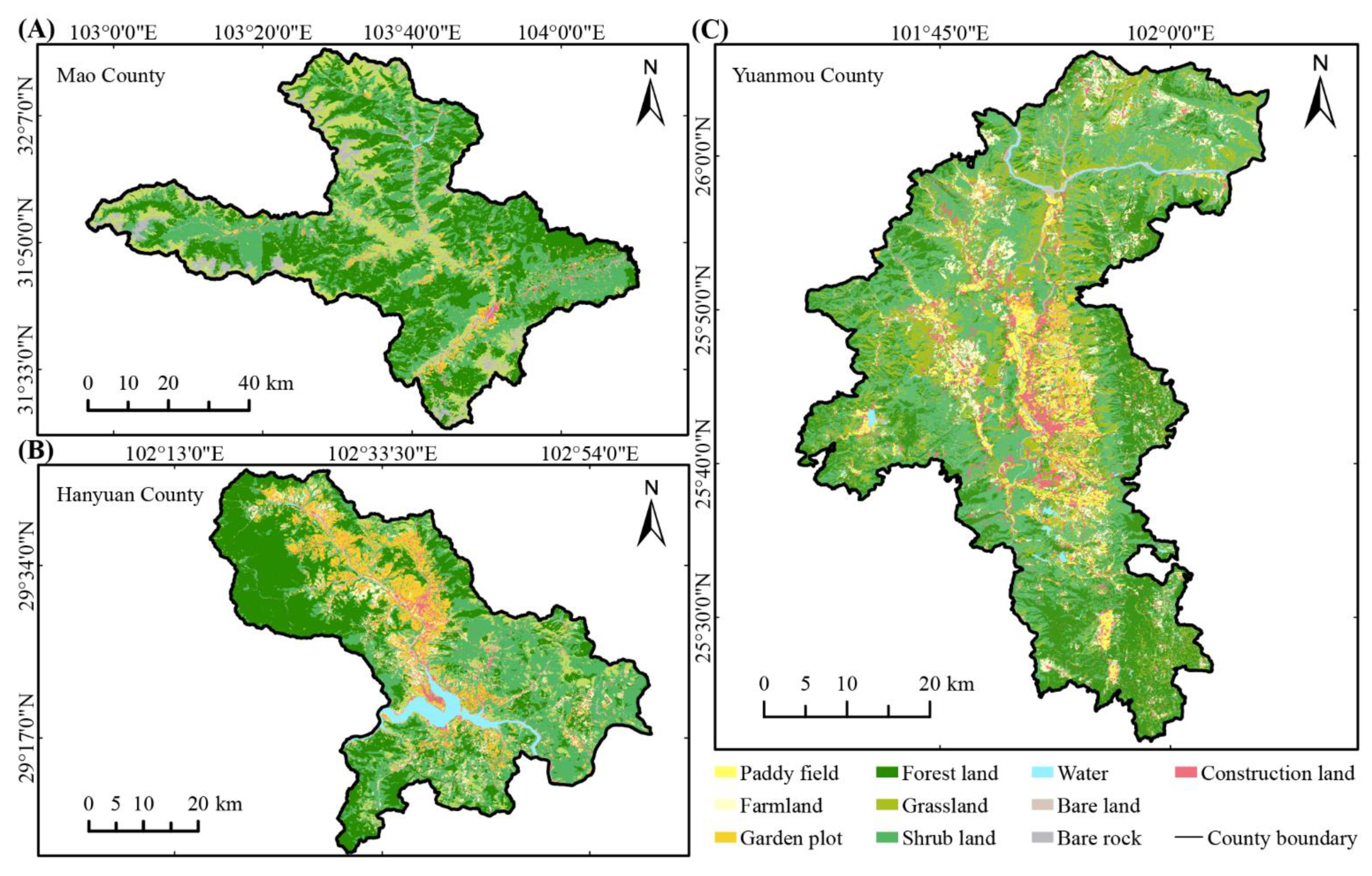
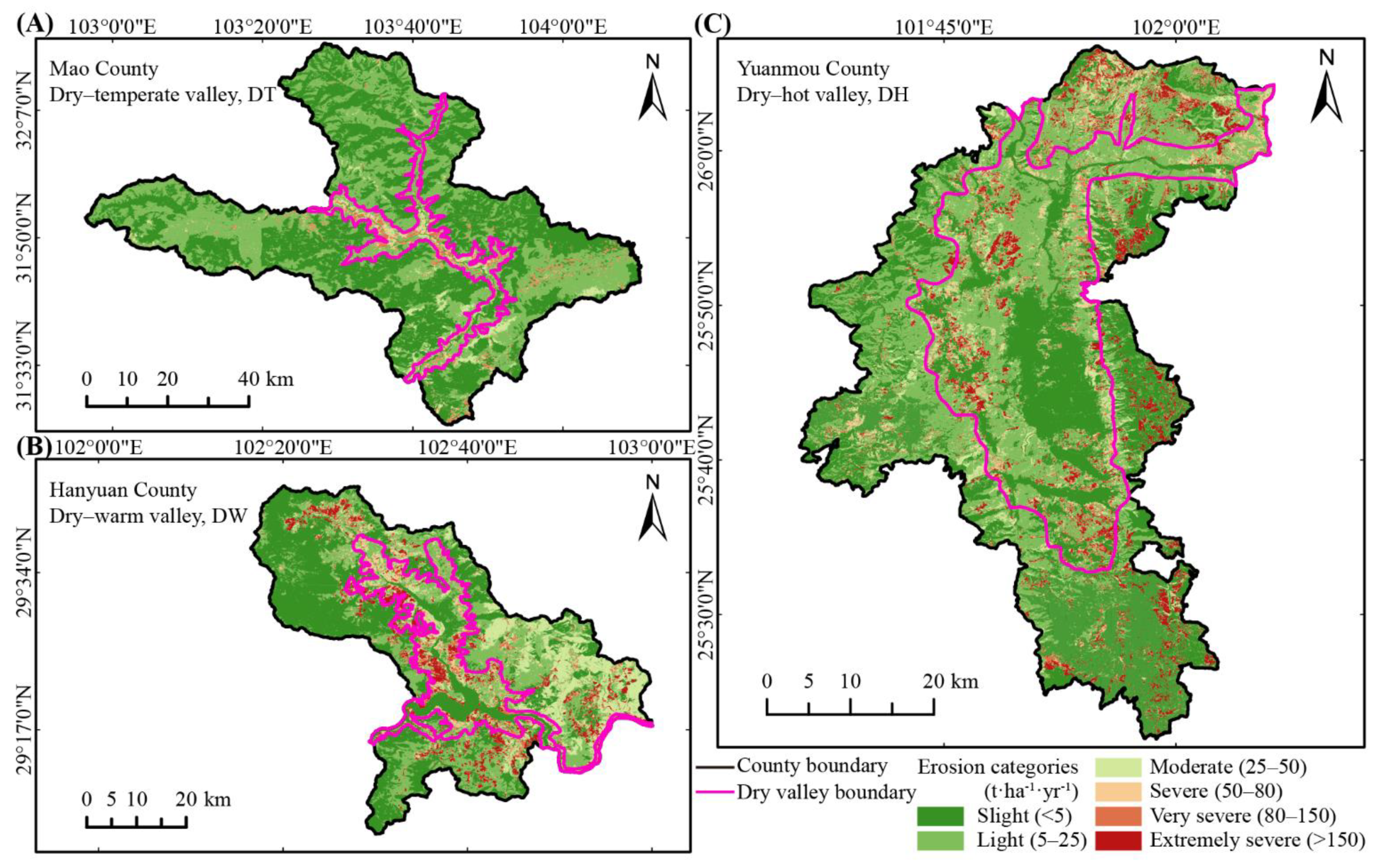
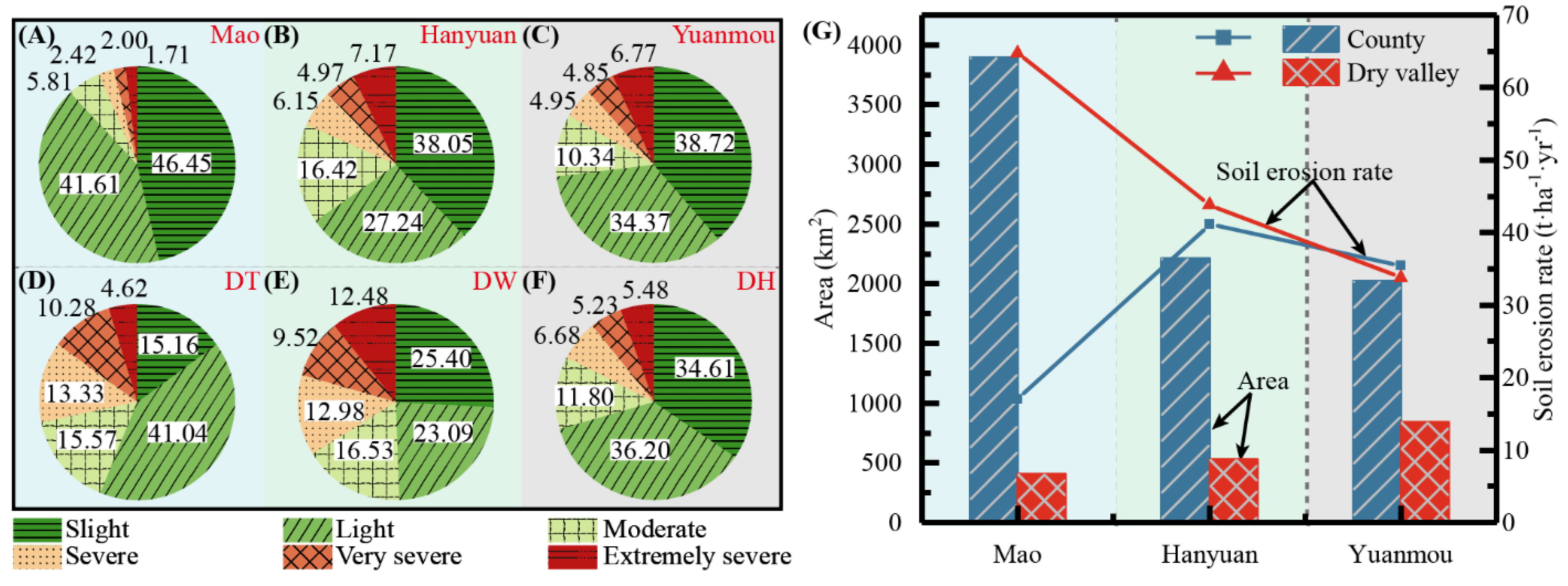
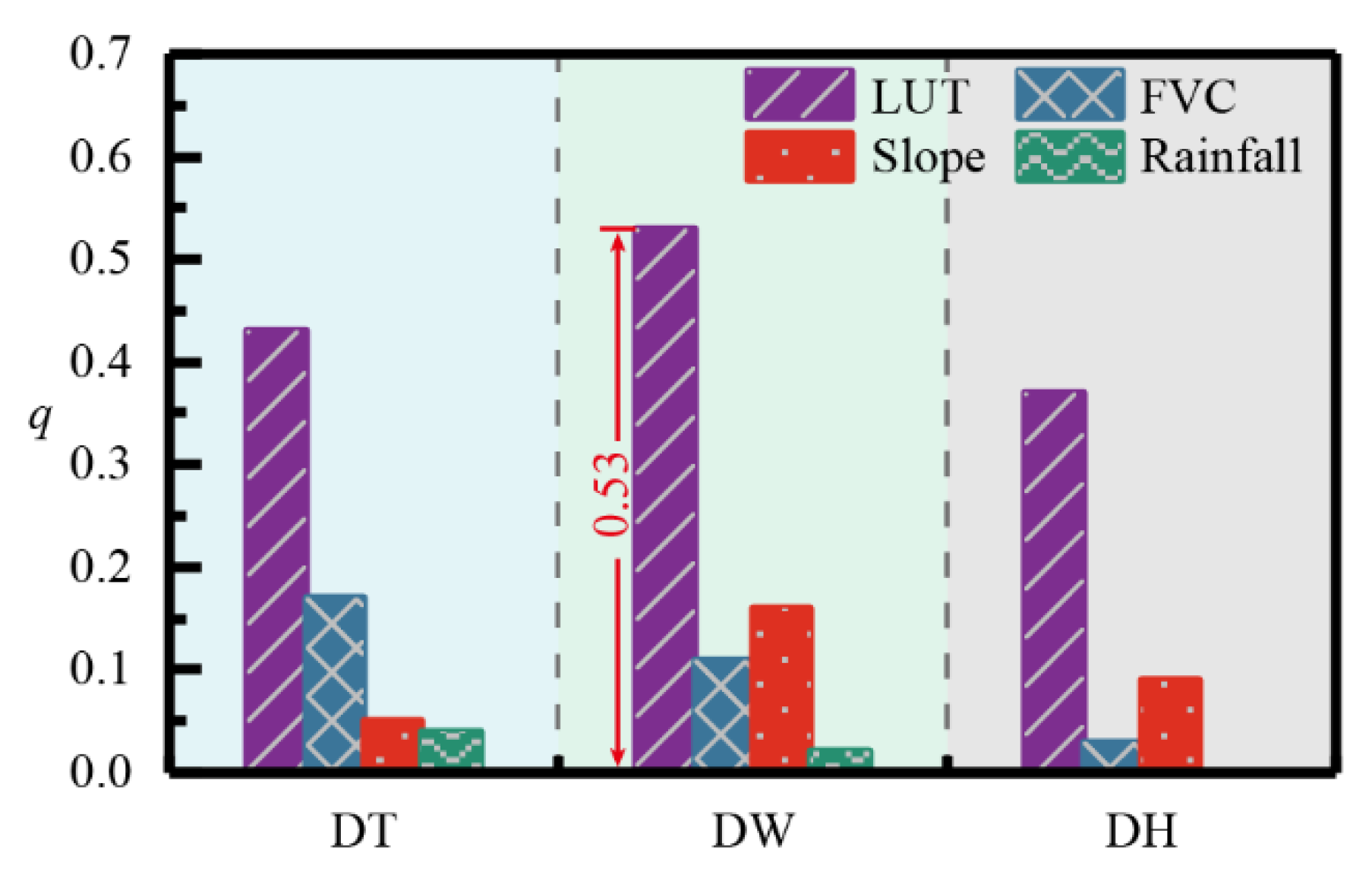

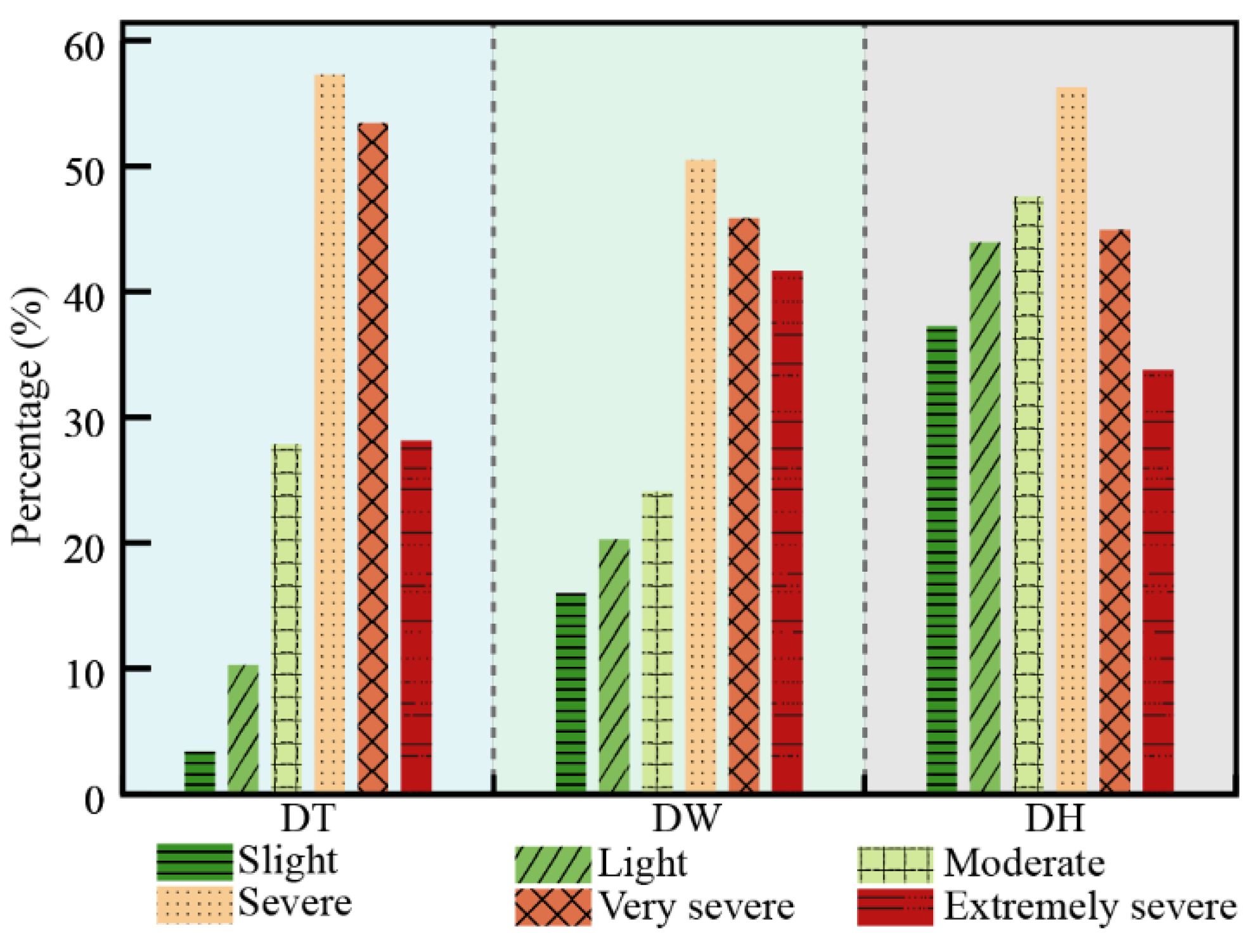
| County | Mao | Hanyuan | Yuanmou |
|---|---|---|---|
| Area (km2) | 3896.65 | 2214.80 | 2021.69 |
| Vegetation | Warm needle-leaved forest and deciduous broadleaved forest | Warm deciduous broadleaved thicket, evergreen sclerophyllous forest and evergreen broadleaved thicket | Savanna and succulent thicket |
| Watershed | Upper Reaches of Min River | Dadu River Catchment | Jinsha River Catchment |
| Annual mean precipitation (mm) | 486.30 | 714.80 | 613.80 |
| Annual mean temperature (°C) | 11.20 | 17.90 | 21.90 |
| Mean steepness (°) | 34.08 | 29.98 | 20.64 |
| Mean lengths of slope (m) | 20.20 | 18.60 | 14.50 |
| Valley shape | V-shaped valley | U-shaped valley | Basin |
| Mean width of the bottoms of valleys (km) | 0.41 | 1.89 | 5.97 |
| Land-Use Type | Sand (%) | Silt (%) | Clay (%) | Organic Carbon (%) | Soil Bulk Density (kg·dm−3) |
|---|---|---|---|---|---|
| Ferric Lixisols | 23 | 30 | 47 | 1.38 | 1.34 |
| Humic Acrisols | 50 | 27 | 23 | 1.80 | 1.31 |
| 28 | 22 | 50 | 3.07 | 1.27 | |
| Gelic Leptosols | 56 | 38 | 6 | 1.41 | 1.30 |
| Eutric Regosols | 47 | 34 | 19 | 0.98 | 1.21 |
| Haplic Acrisols | 27 | 25 | 48 | 1.24 | 1.25 |
| Haplic Luvisols | 41 | 37 | 22 | 0.74 | 1.43 |
| 82 | 8 | 10 | 0.40 | 1.43 | |
| 31 | 22 | 47 | 1.20 | 1.31 | |
| Eutric Leptosols | 46 | 34 | 20 | 1.13 | 1.39 |
| Gelic Cambisols | 31 | 49 | 20 | 2.02 | 1.39 |
| Mollic Leptosols | 35 | 45 | 20 | 3.02 | 1.14 |
| Eutric Cambisols | 23 | 29 | 48 | 1.17 | 1.28 |
| 42 | 36 | 22 | 1.00 | 1.37 | |
| Dystric Regosols | 42 | 37 | 21 | 1.39 | 1.33 |
| Chromic Luvisols | 27 | 27 | 46 | 1.20 | 1.37 |
| Calcaric Regosols | 44 | 35 | 21 | 0.75 | 1.37 |
| Humic Cambisols | 41 | 36 | 23 | 2.72 | 1.10 |
| Dystric Cambisols | 42 | 38 | 20 | 1.45 | 1.30 |
| Ferralic Cambisols | 51 | 26 | 23 | 1.02 | 1.29 |
| Calcaric Cambisols | 36 | 43 | 21 | 0.65 | 1.41 |
| Chromic Cambisols | 49 | 28 | 23 | 0.98 | 1.31 |
| 21 | 29 | 50 | 1.43 | 1.23 | |
| Cumulic Anthrosols | 29 | 50 | 21 | 1.12 | 1.41 |
| Land Use Type | FVC (%) | |||||
|---|---|---|---|---|---|---|
| <10 | 10–30 | 30–50 | 50–70 | 70–90 | >90 | |
| Forest land | 0.100 | 0.080 | 0.060 | 0.020 | 0.004 | 0.001 |
| Shrub land | 0.400 | 0.220 | 0.140 | 0.085 | 0.040 | 0.011 |
| Garden plot | 0.450 | 0.240 | 0.150 | 0.090 | 0.043 | 0.011 |
| Grassland | 0.420 | 0.230 | 0.140 | 0.089 | 0.042 | 0.011 |
| Dry Valley Subtypes | Slope Factor | LUT Factor | Rainfall Factor | FVC Factor | ||||
|---|---|---|---|---|---|---|---|---|
| Slope (°) | A | LUT | A | Rainfall (mm) | A | FVC (%) | A | |
| DT valley | 35–40 | 12.26 | Farmland | 26.86 | 506–566 | 6.52 | 40–50 | 11.85 |
| DW valley | 30–35 | 5.39 | Farmland | 24.10 | 782–842 | 8.43 | 60–70 | 11.17 |
| DH valley | 15–20 | 5.20 | Farmland | 12.93 | 651–711 | 7.33 | 70–80 | 5.86 |
| Study Area | Method | Water Erosion Rate (t·ha−1·yr−1) | Erosion Categories | References |
|---|---|---|---|---|
| Upper Reaches of Min River | RUSLE | 22.75 | Light | Jiang L. et al. [22] |
| RUSLE | 16.73 | Light | Yang M. et al. [47] | |
| Dadu River Catchment | DRBSLE | 43.42 | Moderate | Guo B. et al. [48] |
| Modified USLE | 48.89 | Moderate | Xin Z.Y. et al. [21] | |
| Yuanmou County | Runoff plot | 45.06 | Moderate | He Z.Y. et al. [20] |
| Mao County 1 | RUSLE | 17.02 | Light | In this study |
| Hanyuan County 2 | RUSLE | 41.17 | Moderate | In this study |
| Yuanmou County | RUSLE | 35.49 | Moderate | In this study |
| Land Use Type | Area (km2) | Water Erosion Rate (t·ha−1·yr−1) | ||||
|---|---|---|---|---|---|---|
| DT | DW | DH | DT | DW | DH | |
| Paddy field | 0.04 | 19.84 | 102.12 | 0.40 | 0.48 | 3.49 |
| Farmland | 11.53 | 66.66 | 106.42 | 25.55 | 29.61 | 33.20 |
| Garden plot | 83.96 | 176.86 | 51.87 | 6.13 | 8.36 | 8.66 |
| Forest land | 34.94 | 27.95 | 91.06 | 15.06 | 14.12 | 19.16 |
| Grassland | 136.55 | 36.72 | 138.31 | 20.46 | 19.12 | 30.61 |
| Shrub land | 101.48 | 93.11 | 269.12 | 23.02 | 29.06 | 32.16 |
| Bare land | 0.09 | 0.37 | 3.76 | 5.14 | 5.27 | 5.11 |
| Construction land | 17.84 | 37.40 | 54.57 | 4.27 | 5.11 | 4.50 |
| Study Area | Single Factor | Interaction between Two Factors | |
|---|---|---|---|
| Dry valley areas | Dry-temperate valley | Land-use type | Land-use type ∩ FVC |
| Dry-warm valley | Land-use type ∩ Slope | ||
| Dry-hot valley | |||
| Karst areas | Middle elevation plain | Land-use type | Land-use type ∩ Rainfall |
| Middle elevation terrace | Land-use type ∩ Slope | ||
| Middle elevation hill | |||
| Small relief mountain | |||
| Middle relief mountain | |||
Publisher’s Note: MDPI stays neutral with regard to jurisdictional claims in published maps and institutional affiliations. |
© 2021 by the authors. Licensee MDPI, Basel, Switzerland. This article is an open access article distributed under the terms and conditions of the Creative Commons Attribution (CC BY) license (https://creativecommons.org/licenses/by/4.0/).
Share and Cite
Yang, C.; Fan, J.; Liu, J.; Xu, F.; Zhang, X. Evaluating the Dominant Controls of Water Erosion in Three Dry Valley Types Using the RUSLE and Geodetector Method. Land 2021, 10, 1289. https://doi.org/10.3390/land10121289
Yang C, Fan J, Liu J, Xu F, Zhang X. Evaluating the Dominant Controls of Water Erosion in Three Dry Valley Types Using the RUSLE and Geodetector Method. Land. 2021; 10(12):1289. https://doi.org/10.3390/land10121289
Chicago/Turabian StyleYang, Chao, Jianrong Fan, Jiali Liu, Fubao Xu, and Xiyu Zhang. 2021. "Evaluating the Dominant Controls of Water Erosion in Three Dry Valley Types Using the RUSLE and Geodetector Method" Land 10, no. 12: 1289. https://doi.org/10.3390/land10121289






